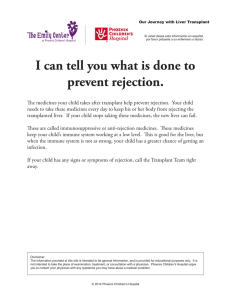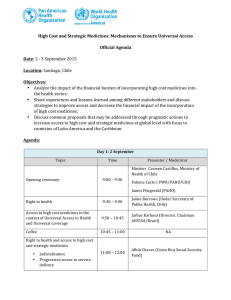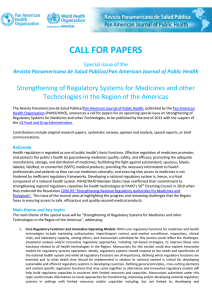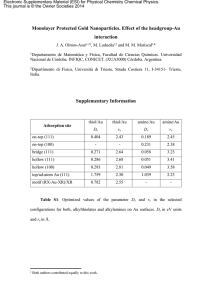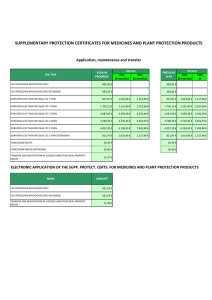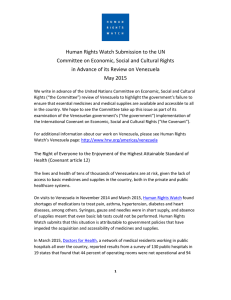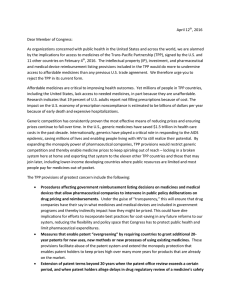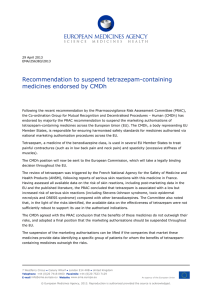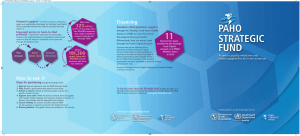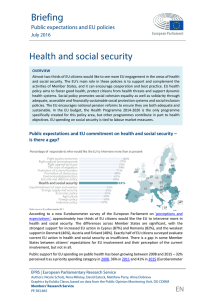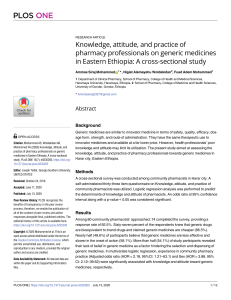NPS MEDICINEWISE: IMPROVING MEDICINE AND MEDICAL
Anuncio
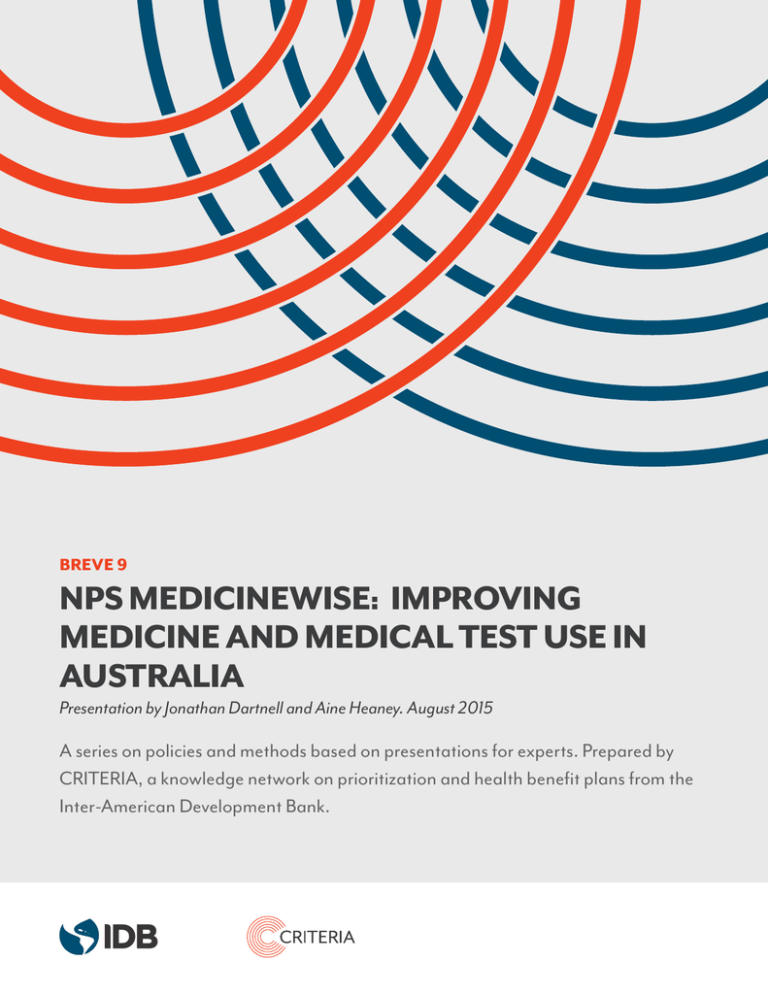
BREVE 9 NPS MEDICINEWISE: IMPROVING MEDICINE AND MEDICAL TEST USE IN AUSTRALIA Presentation by Jonathan Dartnell and Aine Heaney. August 2015 A series on policies and methods based on presentations for experts. Prepared by CRITERIA, a knowledge network on prioritization and health benefit plans from the Inter-American Development Bank. Social Protection and Health Division Inter-American Development Bank www.iadb.org/Health - [email protected] Copyright © 2015 Inter-American Development Bank. This work is licensed under a Creative Commons IGO 3.0 Attribution-NonCommercial-NoDerivatives (CC-IGO BY-NC-ND 3.0 IGO) license (http://creativecommons.org/licenses/by-nc-nd/3.0/igo/legalcode) and may be reproduced with attribution to the IDB and for any non-commercial purpose. No derivative work is allowed. Any dispute related to the use of the works of the IDB that cannot be settled amicably shall be submitted to arbitration pursuant to the UNCITRAL rules. The use of the IDB’s name for any purpose other than for attribution, and the use of IDB’s logo shall be subject to a separate written license agreement between the IDB and the user and is not authorized as part of this CC-IGO license. Any dispute related to the use of the works of the IDB that cannot be settled amicably shall be submitted to arbitration pursuant to the UNCITRAL rules. The use of the IDB’s name for any purpose other than for attribution, and the use of IDB’s logo shall be subject to a separate written license agreement between the IDB and the user and is not authorized as part of this CC-IGO license. Note that link provided above includes additional terms and conditions of the license. The opinions expressed in this publication are those of the authors and do not necessarily refl ect the views of the Inter-American Development Bank, its Board of Directors, or the countries they represent. 1 NPS MEDICINEWISE: IMPROVING MEDICINE AND MEDICAL TEST USE IN AUSTRALIA and used.4 The webinar focused on the role of NPS in improving the use of medicines in the Australian health care system and shows that the investment in NPS MedicineWise’s program has consistently achieved demonstrable improvements in the use of medicines and medical tests. Moreover, it has resulted in improved health outcomes and savings in government expenditure far in excess of the cost of the programs. The NPS model plays an important role in supporting Medicare, Australia’s universal health system. INTRODUCTION The experience of NPS in promoting the This Breve is based on a webinar1 presented rational use of health technologies is extremely by Jonathan Dartnell and Aine Heaney , at relevant for anyone interested in improving the NPS MedicineWise, on August 18 of 2015, to allocation of scarce health resources to what the members of CRITERIA, the IDB Knowledge is most important for the population; even the Network on Health Benefits Packages and best and most evidence based allocation of Priority Setting in Health. resource decisions at the macro level fail unless 2 3 prescribers, patients and population in general The webinar presented the role of NPS makes the right decision on what technologies MedicineWise in the Australian health system. actually to consume. NPS is a not-for-profit organization whose programs are funded by the Department of Health (Australia). It provides practical tools (such as medicines lists), evidence-based information, and educational activities, with the intention of improving the way health technologies, including how medicines and medical tests, are prescribed 1 To access the audio and the PowerPoint files for the presentation of the webinar click here: http://www. redcriteria.org/webinars/ 2 Clinical Governance and Program Development Manager at NPS MedicineWise 3 Client Relations Manager 4 Wikipedia 2 OVERVIEW OF PRESCRIBING IN THE AUSTRALIAN HEALTH CARE SYSTEM Approximately 9% of GDP goes to health Australia has a universal healthcare system that in the Asia-Pacific region. (Graph 2) expenditures, which is somewhat similar to many countries in Latin America and the Caribbean, and about 15% of the health care budget is spent on medicines, which is close to the OECD average, but lower than the average of countries provides access to medicines, medical tests, medical practitioners and hospital care, delivered through public and private providers. Funding comes from the federal government as well as state governments with small portions coming from health insurance funds and individual contributions (Graph 1). 3 Australia has a National Medicines Policy, comes in, intervening within the interconnections depicted in Figure 1. Quality use of medicines of the policy through a national coordinated and healthy consumers are in the center of the approach to appropriate use of medicines. policy. The first pillar of the policy is to provide standards of quality, safety and efficacy of medicines which is achieved and regulated through our Therapeutic Goods Administration. The second pillar of the policy is to provide equitable, timely and affordable access to medicines, which is achieved through the Pharmaceutical Benefits Scheme (PBS). The third pillar is a responsible and viable pharmaceutical industry and the fourth is supporting quality use of medicines. Here is where NPS MedicineWise 4 The PBS is an extensive scheme, which provides The Pharmaceutical Benefits Advisory access to over 750 different drug substances, Committee (PBAC) is a statutory committee equating to 2,000 forms for 4,500 different established under the National Health Act products. In 2013 there were about 200 million in charge of assessment of medicines for prescriptions on that scheme, at a cost of reimbursement. The Health Minister cannot list about 9 billion AUD (6.6 billion USD). Patients a medicine under the PBS without a positive are required co-payments, the concessional recommendation from the PBAC. The sponsor, payment is about 6.1 AUD (4.50 USD) and for usually the pharmaceutical industry makes general patients about 37.7 AUD (27.8 USD). requests for listing on the scheme, including type 5 of listing (e.g. generally available, restricted or prior authorization). To make a recommendation, the PBAC is required by legislation to consider: comparative efficacy and safety, costeffectiveness and total budget impact. Medicines can be either unrestricted and available to everyone or restricted to specific indications and they may require prior authorization before use, which can be through a streamlined approval, telephone approval or written approval in the most extreme circumstances. Figure 2 describes the process for listing on the PBS. Once a drug is registered it undergoes an economic analysis, estimates of utilization are made, and the criteria for its use and pricing are negotiated and established. Then the medicine becomes subsidized and is made available for use in the market. 6 7 FROM EVIDENCE TO PRACTICE IN PRESCRIBING AND USE OF MEDICINES AND MEDICAL TESTS such as antibiotics for upper respiratory tract Australia is quite well served with good In Figure 3 the pyramid shows the process of formularies and guidelines. For example, we have evidence distillation and from the distillation the an Australian medicine handbook and there is a course towards useful practice recommendations. therapeutic guidelines series of clinical practice Implementation of several aspects needs to guidelines, both for common and uncommon occur: health professionals need to be aware conditions. These are produced by independent of that evidence, accept it and be able to apply non-profit organizations. Yet, availability of it to suitable circumstances, and finally act good information doesn’t guarantee good use appropriately towards agreement and adherence or evidence going into practice. So we see of the patient to those recommendations. There many examples of suboptimal prescribing, such is a series of cascading steps with diminishing as underuse of beta blockers or inadequate return, which can result in several barriers to dosage of ACE inhibitors for heart failure. There the effective implementation of evidence into are many examples of over use of medicines, practice. infections, benzodiazepines for sleep disorders, antihypertensive and lipid lowering drugs in place of lifestyle modifications. We also see second line before first line therapy, which is the case of using gliptins before metformin. 8 NPS MEDICINE WISE, IMPROVING QUALITY USE OF MEDICINES applicable to their everyday life. We make sure we evaluate the impact of what we do and ensure that we change knowledge, attitudes and behavior to have the best decisions applied to medicines and medical tests. We ensure there is Now let’s turn towards NPS as an organization always a continuous loop in our learning about and who we are. NPS is a relatively young the work that we do, our evaluation of our work company, around since 1998. Our purpose and the people we most want to affect. ultimately is to achieve better health and economic outcomes for Australia. In the way that we do that we enable people to make better decisions about medicines and other medical choices. The Australian government largely funds us, but we have an independent board, a membership base that directs what we do. Working in partnership with other organizations, we have a fair understanding of what the country requires. We work separately, but cohesively, with both health professionals and consumers. Our definition for quality use of medicines includes the wise selection of necessary, suitable, safe and effective treatments (including prescription, non-prescription and complementary medicines). To conceptualize our work (figure 4), think about the wealth and enormous amount of evidence that is been developed in medical trials and other research. We know that health professionals are not necessarily well placed to assimilate a lot of information for themselves. We believe we play a role in synthesizing and developing evidence-based knowledge from a distillation through the pyramid on what is the best use for medicines and medical tests. We try to make this information pragmatic in terms of connecting it with our audience to make it influential, 9 The Australian health care system is very piece of our work is quality improvement, by interconnected, so there are a range of contributing to the evidence base on how influences that can be brought on how the medicines and medical care should be used system operates and we try to work with and using a number of techniques and methods all of these systems. Figure 5 depicts the to influence how decisions are made. Our types of approaches that we use throughout audiences in Australia are wide, involving health the lines of work that we do. A fundamental professionals and students, engagement with 10 government stakeholders and the pharmaceutical industry, as well as outreach to consumers and communities We work very closely with family physicians or general practitioners but we also know we need to work with specialists and people who are involved with medication management such as pharmacists and the nurses who support medication use. When health professionals are in practice we also try to work with them regarding making good decisions on medicines. We have a number of drug and therapeutic information resources that are regularly mailed to clinicians in Australia. We have a publication, Australian Prescriber that makes reviews and updates about new drugs and evidence. We do a lot of work with pharmacists. We are We have a publication called NPS Radar, which very lucky in Australia to have a very wide informs about drugs that are included in the distribution network of medicines that includes listings, and their benefits, and potential side private pharmacists, and given they do a effects. Other regular mailings provide information lot of face to face, day to day interventions on what is happening in the drug landscape. We with consumers, they are great partners. provide comparative prescribed feedback to We provide them with opportunities to have clinicians on regular basis and provide reflective multidisciplinary case-based meetings and case activities such as the assessment of own practice study discussions, newsletters, patient support in comparison with evidence-based benchmark materials and other resources that can be used or their peers. We undertake academic detailing, every day to ensure quality of medicines. which delivers face to face tailored messages for clinicians about what best practice is, and is provided by educational facilitators who often are pharmacists but also other health professionals. 11 We are very active in the early years of and free air television channels. Also, we have good continuing education of health professions’ relationships with other websites or other media students. We have a national prescribing services, for example a lot of Internet providers curriculum which is based on the WHO guide to be able to insert content when people are to good prescribing. We aim to get students to searching for medicines or other medical be “Practice Ready”, preparing them in good information. Hopefully, we have “search engine prescribing through their undergraduate, so that optimization” so we occur very high in people’s when they get out to practice they are informed searching to give them unbiased information. about the nature of drugs, when things work and (Figure 6) when they don’t, and the costs and benefits of their prescriptions. In addition, we try to work directly with consumers. We know that consumers have many ways to acquire information about medicines and health through family, friends, and clinicians, but also increasingly doctor Google and group and social media. So we try to utilize many gateways to ensure that best medicines and information are available. We have a number of newsletters and print publications, and tools and resources to help people asses their medicines and medical treatments. Besides that, we also have phone lines support for consumers, so we run In between decision-making we also try to two phone lines where people can ask questions influence people thinking and the whole about medicines or they can ring up and report process and we employ a lot of very influential intended or unintended consequences of international recognized techniques that are medicines. We capture that information and feed shown and assist to that. But also, we try to be it up to the regulator as part of our obligation to influential where decisions are immediately the government. We have tools and apps that made; we have a number of ways of both can be used on iPads or smartphones to help passive and active decision support in Australia. people have ways to manage their medicines, For example, when clinicians are prescribing a such as keeping a medicine list receiving medicine or ordering a medical test where there reminders to take their medicines or keep can be a lot of pop ups and reminders on their records of biomarkers such a blood pressure. We computer with the latest evidence and influence have very good partnerships with many of the that decision. media channels in Australia so we work with the 12 Again, we try to get involved in very important Within our evaluation framework, we must make public health issues, such antibiotic resistance. sure professionals and audiences are aware As part of the international antibiotic awareness about the different products and services that week that takes place each year in November, we make available; that they have access to we execute a campaign around the overuse of them in an appropriate way; that they participate antibiotics both with consumers and clinicians. in those activities and are exposed to the This year we were very lucky to get involved program messages. Thus, we can determine with a new initiative, which is a short-film through different surveys and other techniques competition for young filmmakers that make if attitudes, skills and knowledge have changed excellent, interesting and very funny short videos (Figure 7). on YouTube (Antibiotic resistance, Pick Up, antibiotics don’t be a jerk) . It has been very successful in terms of reaching young people and getting them interested in the topic of antibiotic resistance. EVALUATING NPS MEDICINE WISE’S IMPACT NPS real purpose for existing is to deliver national programs, which have a clear, strategic objective to improve consumption of medical drugs. The general approach that we take in developing national programs is, while keeping focus on the consumer, to identify clinical issues that are important to health professionals, asses the gaps and barriers between practice and what is actually happening, and enable clinicians On the other hand, it is critical to determine to change their practice. We create evidence- whether or not we make an actual difference based messages, very simple messages about on the prescribing practice or use of medicines, how to change practice. And we deliver these and ultimately, if we have been able to improve messages across disciplines through a range of health outcomes. This can be better understood interventions as those already described. It is through an example of one of our programs. important for us to learn from our programs, but The Dementia program was delivered between also to evaluate if we have made a difference. 2008-2011, with the objective to improve 13 management of dementia, in particular the through a trial for withdrawal of antipsychotics use of cholinesterase inhibitors, memantine, if no clear benefits were seen. The program and antipsychotics. The audience included developed targeted information resources, made general medical practitioners, community case studies available, facilitated small group pharmacists, nurses working in aging care, case based discussions and provided interactive and consumers and their careers. The main multi-disciplinary workshops and also made program messages were the uses of non- academic detailing visits to general medical pharmacological strategies for all stages of practitioners across the country. dementia. It is known that the benefits of cholinesterase inhibitors and memantine are Pictogram 1 gives a summary of the Dementia quite small, and some patients will not respond, program. There were 37% of registered GPs and adverse effects are common. Therefore, the actively participating in the program (there were patient should be monitored and there should also many pharmacists and nurses). The program be an objective assessment of the effectiveness achieved positive changes in knowledge; and of cholinesterase inhibitors and memantine. participation satisfaction; a significant reduction There has to be a plan to review medications in the rates of prescribing as well as reduction in regularly as well as opportunistically. Patients antipsychotic use, and savings to the PBS. and their careers should be counseled on the limited benefits of drug therapy. In addition, the program had messages for residential age care, 14 Graph 3 explains how we measure our impact Other programs address Type II diabetes, on prescribing; we used the entire national achieving significant improvement in the administration database for the PBS for use of metformin, reduced hospitalizations cholinesterase inhibitors and memantine and from CV events and amputations, while applied a time series analysis technique to link it also demonstrating reductions in the use with participation in the program. The purple line of glitazones, which has resulted in PBS represents the participation in our program in savings. Regarding stroke prevention there that period of time; the blue triangles represent has been an increase in the use of aspirin and actual expenditure on those medicines; the red reduction in clopidogrel, again achieving PBS line represents the estimated expenditure with savings and reduction of hospitalization for existence of the NPS intervention; the green primary stroke. There are other examples of line the estimated expenditure without the successful programs addressing depression, intervention; and the yellow space represents gastroesophageal reflux disease, vitamin D the savings achieved through the actual program testing and low back pain imaging. and demonstrated reductions in prescribing rates in the pharmaceutical scheme. 15 REFERENCES THE BOTTOM LINE OF QUALITY USE OF DRUGS Organization for Economic Cooperation and We think NPS can make a case for investing Development. Health Database, 2012. in national programs to improve medicine and Available at: http://www.oecd.org/els/ medical test use. Our programs add value health-systems/health-data.htm to registration and subsidization processes. They are accepted, valued and supported by Wikipedia. Australian Health System. Available health professionals and consumers. They at: https://en.wikipedia.org/wiki/Health_ have demonstrated changes in attitudes and care_in_Australia knowledge as well as changes in practices, in particular in prescribing. And the accumulated World Health Organization, Global Health savings that we achieved on medicines and Expenditure Database, 2012. Available at: medical tests for the Australian Government may http://apps.who.int/nha/database rise to AUS$730 million. We also have been able to demonstrate more recently how we contribute to generate better health outcomes. 16 Priorización y planes de beneficios en salud
